Technology and Science Education
The quotations on Introduction and Conclusions refer to science, technology and innovation, and express the view that technological innovations come from concepts previously discovered in scientific research. This view is examined on Technology, research, development, and science, and found to be popular, but not supported by the findings of research. There was a suggestion that the view is popular because it is influential in education.
The relationships between scientific research, technical development and education have been part of policy discussions in England since at least 1868 (pdf). More recently, there has been further debate and some reforms of the teaching of science and technology (see below). In particular, Paul Gardner has proposed four differing views of the relationship between them, and found various expressions and embodiments of these views in the teaching curriculum. The teaching of science and technology varies considerably between countries, even among those who participate in international comparison exercises like PISA and TIMSS.
On this page some readily available documentation from France, Scotland, England, the USA, and the International Baccalaureate is examined. Basic information is considered first: the titles of courses and the numbers of pupils entering them; how the courses are described; the course assessments and what grades are achieved. These figures give an indication of the practical outcomes of the differences in the structures of national systems, and the differences between the positions of science and technology within them. The initial discussion of these figures is in terms of the titles of the courses, without considering what their actual content is, or what the intentions of their curriculum designers were.
These intentions are sometimes published when the curriculum is reconsidered and revised. In the process, explicit statements about the nature and relations of science and technology are made. The second section of this page looks at how these statements express a view of the origins of innovation and the nature of science and technology. Comparisons are also made with the corresponding published curricula, which are not always consistent with the statements on which they are supposed to be based.
On another page, A problem in the history of science and technology, there is a discussion of views on the early history of steam power. The view that the practitioners who developed the technology were enabled by contemporary scientific research is widely held, but is found to be unsubstantiated. It suggests that one reason for that mistaken consensus view lies in the education undergone by those who hold it. That suggestion is reviewed in the light of evidence on this page. Many of the curriculum statements examined here illustrate their explanation of the relationship between science and technology by reference to their histories. This underlines the importance of how we tell history, and how we see it in the light of what we have been told.
Many alternative ways to develop science and technology education have been proposed, based on alternative views of the relations of science and technology, on improvements in pedagogy, on the experiences of students after secondary education, and on attempts to attract and involve more entrants to technical subjects. The third section of this page examines some of these alternatives. One of the difficulties in developing alternatives is in presenting a technical understanding of a technical problem, rather than limiting the understanding to what is taught in a science curriculum. Raising water shows that the development of the early steam engine can be well understood in the technical terms familiar to the practitioners who carried it out.
Existing systems
Numbers and grades
England


In England in the years of compulsory education to age 16, science, along with maths and English are designated as core subjects, which all pupils must be taught. The National Curriculum for England prescribes science and Design and Technology (D&T) and Computing as compulsory subjects up to age 14. In the two senior years of secondary education, which lead to the GCSE qualifications at age 16, D&T is optional. GCSE sciences are arranged to attract the widest range of entrants, being offered in a full curriculum (single sciences) or a reduced curriculum with less maths (combined science). For both, two exams are available: a foundation tier on which grades up to 5 may be awarded, and a higher tier, on which grades from 4 to 9 may be awarded.
The outcome of these arrangements is that in 2019 there were over nine times as many GCSEs awarded for science subjects as there were for technical subjects. The grades achieved in science are also different from those in technology: in 2019, the proportion of entrants in technical subjects graded 6 and above was 33%, similar to the overall figure for all GCSEs. In combined science the proportion was 36% and in the single sciences, taken by those expecting further study in sciences or technical subjects, the proportion was 70%. Science not only dwarfs technology in participation, but also disproportionately attracts the higher performing pupils.

This order of things is reaffirmed in current policy. Since 2010 the UK Department for Education has defined the English Baccalaureate as a set of subjects at GCSE that keeps young people’s options open for further study and future careers
. The set includes either three single subjects from biology, chemistry, physics and computer science, or combined science. The rationale for this is the statistical observation that
…studying subjects included in the EBacc provides students with greater opportunities in further education and increases the likelihood that a pupil will stay on in full-time education.…The government’s ambition is to see 75% of pupils studying the EBacc subject combination at GCSE by 2022, and 90% by 2025.
The government's ambition is limited to shaping secondary education to conform to the requirements of further education, leaving any possibility of improving the latter out of the question.
Further education qualifications taken at age 18 in England are classified as academic (A level) or vocational (applied general or tech level). A levels are the gateway qualification to higher education: in 2016 71% of entrants to higher education in the UK were admitted on their A level grades. The most popular vocational qualifications at this level are BTEC Nationals, which are described as vocational qualifications that provide specialist, work-related learning in a range of sectors
and equip students with the specialist knowledge, practical skills and understanding they need to progress along their chosen learning and career paths.
In 2016 this route was taken by 11% of entrants to higher education in the UK.
There is a well documented perception of vocational pathways as being low status
(Rodeiro & Vitello pdf p10). Of entrants to higher education who obtained high grades in A levels, 80% were accepted at high tariff institutions, but of those obtaining equivalent high grades in BTEC, only 8% were accepted at these institutions. This divide between academic and vocational qualifications also separates science and technology subjects in England. In in 2019 there were seven A levels awarded in science subjects to every one in technology. More students take A levels than vocational qualifications, in the ratio 5 to 3, but in vocational qualifications at this level in 2017 the number of students engaged in technical subjects was ten times greater than it was in A levels. The ambitious or high attaining student is given firmly to understand that the route to success in technical subjects is via studying science in post-16 education.
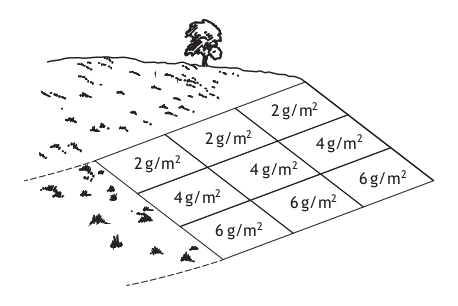

Scotland
The Scottish Curriculum for Excellence comprises eight subjects, including sciences and technologies, to age 14, followed by three senior years in which courses leading to National Qualifications may be taken. There are courses leading to graded qualifications at level 5, taken at age 15, Higher (gateway to Scottish HE) taken at 16 and also 17, and Advanced Higher taken at age 17, about five times less popular than Highers.
In 2016 to 2018 there were seven technical subjects and three core sciences available at both level 5 and Higher level. At level 5, sciences had 2·4 times more entrants than the technical subjects, for sciences and average of 54% obtained grades in the upper half of the scale, and for technical subjects the average was 57%. In Highers, there were twice as many entrants for sciences as there were for technical subjects, 52% obtained grades in the upper half of the scale in science subjects, and 47% in technical subjects. In Advanced Highers there were seven times as many entrants for sciences as there were for technical subjects.
The extreme imbalance between science and technology which is seen in general education in England, in the number of entrants and the level of their attainments, is not evident in Scotland. The Scottish preparation for higher education in science and technology is not of lower quality or less attractive than the English: the proportion of students subsequently accepted for technical and science courses in HE in the UK is greater for Scottish than for English students, and among those courses the proportion accepted for technical courses is also greater for Scottish students.
The relegation of technology to the vocational ghetto
(Bell & DonnellyJacqueline Bell & James Donnelly (2009) Applied Science in the English
school curriculum: the meaning and significance of ‘vocationalization’, Journal of Curriculum
Studies, 41:1, 25-47, DOI ) may not be the sole cause of its relatively low esteem in England. There are many other differences between a Scottish and an English education: the Scottish system is broader, less rigid, more inclusive and more pupil centred. Changes in recent years in both countries have, if anything, served to increase these differences (pdf and below)
USA
Public secondary education in the United States is run by each state separately. Engineering and technology standards are published as part of a state's science standards, even if the subjects are taught as a separate discipline. In 2011 the engineering content in the science standards of the states varied from zero to 26%, with a median between 2% and 3% (Tamara J. Moore et al). Massachusetts, Pennsylvania and Oregon had more than 20% engineering content; all three presented technology/engineering as a separate discipline. In 2013 the Next Generation Science Standards were published. These standards have been adopted in states representing 36% of students, and are influential in states representing a further 35% of students. The engineering content in the NGSS is estimated at about 25% by Moore et al; this content is incorporated into the core science disciplines (see below).
In Massachusetts the new 2016 Science and Technology/Engineering (STE) Standards do not adopt the NGSS treatment of engineering and technology. They describe this treatment as Engineering design as occasional application of science
. In Oregon the NGSS have been adopted, and in Pennsylvania their standards are in the process of being updated, and reviewed in the light of the NGSS.
In California the engineering content in the science standards prior to the adoption of NGSS was estimated as zero; now their 2016 Science Framework follows the new standards. Engineering appears repeatedly in the science framework, identified as providing varieties of relationships between engineering, technology, and applications of science
or Science and Engineering Practices so that pupils can learn how science is applied to solve engineering problems.
In the USA there is no formal separate phase of further education between secondary education and higher education, and no gateway qualifications for entry to higher education institutions. In 2018 three quarters of institutions used one or more admission requirement for bachelors degree courses. Of these, scores on the SAT® or ACT® were used by two thirds of institutions, and scores on the Advanced Placement® program and exams were used by one third of institutions. None of these tests include engineering or technology; ACT requires science, and AP offers sciences. A relatively small number of candidates take the International Baccalaureate. In a typical IB diploma programme, students must study one of six Experimental Sciences, among which are three technical subjects. In 2019, six percent of the IB science program's diplomas were in these subjects, in which the percentages of entrants obtaining the higher grades were only marginally lower than in the core sciences.
Engineering and technology are available in the Technical and Vocational Education and Training (TVET) courses offered in secondary education: about 10% of high school credits obtained are for these courses. The creation and adoption of the Next Generation Science Standards clearly has the potential to bring technical subjects into general education more widely in the USA, and to change how they are perceived. The standards, and their origins, are discussed in more detail below

France
In France in 2015 the national education programmes introduce a single subject of Science et Technologie in cycle 3 (ages 9-12), and three subjects of physical sciences, life sciences and technologies in cycle 4 (ages 12-15). The pupil's choice of two out of three of these are assessed in the DNB tests. The DNB has a vocational stream, the Série professionnelle, taken by 10% of the cohort.
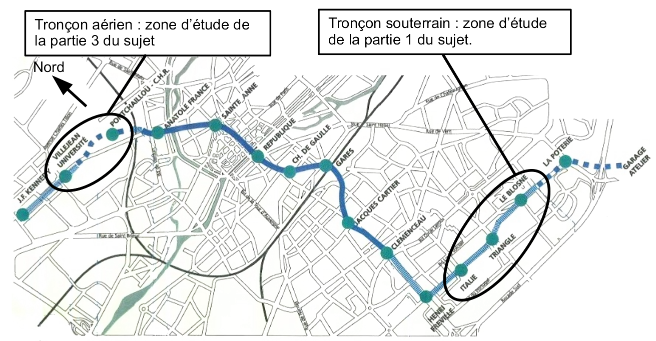
Further education is based on three baccalauréats: général, technologique and professionel. Of the generation of 2019, 43% passed the général, 17% the technologique and 21% the professionel. The général and the technologique lead on to higher education, the professionel leads to employment and is taught in separate, usually specialist, schools. The général leads to bachelor's degree courses and is strongly preferred for entry by the selective grandes ecoles. The technologique covers engineering, laboratory science, business, and health and welfare, and leads mainly to a two year licence, and perhaps eventually to a four year bachelor's degree. The général had three routes, permitting different choices of speciality subjects: 52% of its entrants opted for the Sciences series, of which 20% specialised in engineering or computing, and 60% in physical or life sciences. In these categories the proportion of the candidates who succeeded in obtaining grades in the upper half of the scale were 26% and 28% respectively. In the technologique and the professionel the proportions achieving that success were 14%.
Although a pass mark in baccalauréats is the gateway to higher education, the outcome is that 60% of students do not succeed through a second subsequent year. This is one of the motives for the reorganisation of the baccalauréats for 2021. There will be a single route for the général, and increasing specialisation in its second and third years, retaining a mix of continuous assessment and examinations.
The French system places technology and science alongside each other from an early age, gives each their own distinctive forms, and makes connections between them as it does between other disciplines. They are regarded as twin sisters:
Nous souhaitons que tous les enfants, dès leur jeune âge, acquièrent le goût et une juste vision de la science comme de la technologie, ces deux sœurs jumelles. (pdf)
Technical courses have the same academic level, and attract as many high attaining pupils as the sciences do. Their tests in the sciences require an extended scientific analysis of a technical problem, and in the technologies they requires an extended technical analysis of a technical problem. In the baccalauréat speciality subject Sciences de l’Ingénieur (SI) the final test presents over 20 pages of information on a technical situation, and requires the entrant to complete a guided analysis of it in four hours. The Engineering Science courses offered at senior level in Scotland have similar content, and attract high attaining pupils, but have a smaller proportion of entrants than the French courses.
Review
It might be expected that a strong preference for science over technology in secondary education would be reflected in the numbers going on to higher education. In the UK, for example, in arts and humanities the most popular A level subjects are the most popular university subjects. This is the opposite of the case in science and technology: at UK universities in 2016 there were twice as many enrollments in technology, engineering and medicine as there were in sciences. In the USA in 2018 bachelors degrees awarded in technology, engineering and medicine were three times more numerous than in sciences.
A rationale for this disparity is found in the guiding principles published in the curriculum documents, for example in England:
For some students, studying the sciences in key stage 4 provides the platform for more advanced studies, establishing the basis for a wide range of careers. For others, it will be their last formal study of subjects that provide the foundations for understanding the natural world and will enhance their lives in an increasingly technological society.
Given that the great majority of both these kinds of students will subsequently work on or live with technology, the assumption must be that the science curriculum prepares for the study and understanding of technology better than a technology curriculum would. This assumption might be based on the view that technology is just applied science, or it might be on the view that the science curriculum should be designed to teach technology as well as science. The curriculum development documents published in England and the USA indicates a continuing debate around both these views. Adding technical content to the science curriculum is seen as making it more interesting, more relevant, and so more attractive. At the same time the developments seek to maintain the status of the science content, and to implement the technical content as just demonstrating applications of the science content.
Some of the material from the curricula and their development is examined in the next section. The documents include extensive descriptions of the nature of science and technology, and views on the origins of technical innovation, which is a central theme here, so their story is treated in some detail. Their views can be compared with those of specialists in education, as described below, and with the material presented on Technology, research, development, and science.
Principles in standards and curricula
Science standards in the USA
The 1996 National Science Education Standards (NSES) represented a systemic reform of school science teaching. One of its six chapters is Standards for science content, within which are eight categories, one of which is Science and technology standards. According to the standards, they are not standards for technology education; rather, these standards emphasize abilities associated with the process of design and fundamental understandings about the enterprise of science and its various linkages with technology.
The standard for grades 9-12 states
Students respond positively to the concrete, practical, outcome orientation of design problems before they are able to engage in the abstract, theoretical nature of many scientific inquiries. … students as well as many adults and teachers of science indicate a belief that science influences technology. This belief is captured by the common and only partially accurate definition “technology is applied science.” Few students understand that technology influences science.
There are proposals here on three issues which recur in science standards: that technology appears as a vehicle for teaching science, that technology is not just applied science, and that science education does not cover technology education. If the first proposal were put into practice that would imply a radical revision of the way science was taught, but the NSES offers little guidance as to how that might be done. The standards attempted to accommodate all sorts of people with all sorts of differing and even contradictory views
(DonmoyerRobert Donmoyer, The Rhetoric and Reality of Systemic Reform: A Critique of the Proposed National Science Education Standards, Theory Into Practice , Winter, 1995, Vol. 34, No. 1, Reforming Science Education (Winter, 1995), pp. 30-34), accumulating a mass of recommendations which could never be combined into a practical reform.
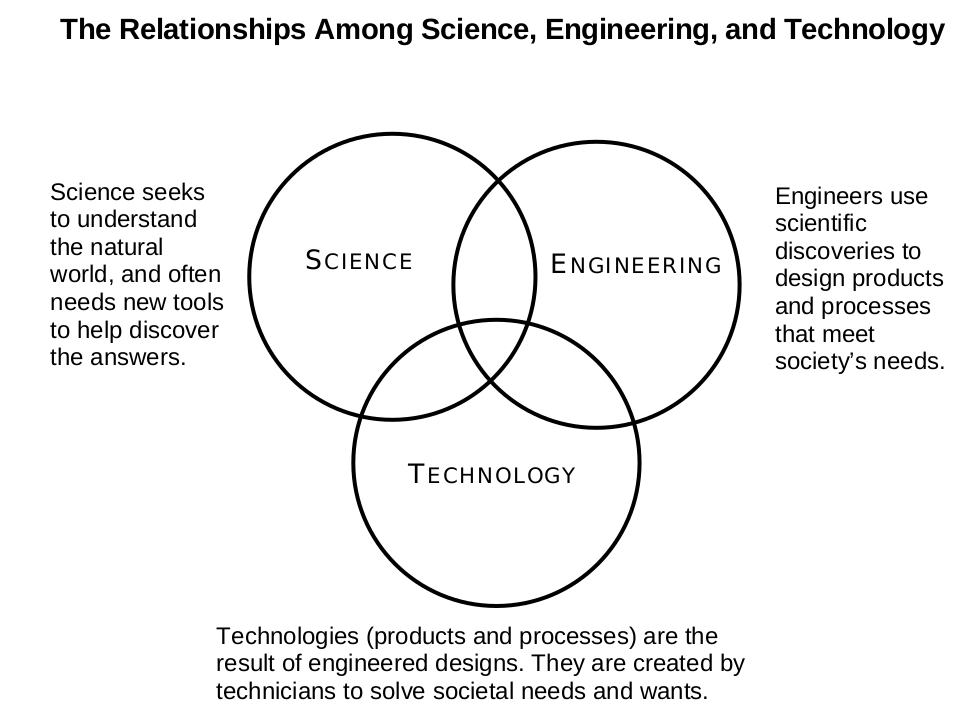
Differing views on the three issues recur in the science standards in different states of the union, with their various levels of technology content. The states also have differing views on the origins of innovation. For example, the 2006 Massachusetts Science and Technology/Engineering Curriculum Framework (pdf) has a separate technology provision, and one of the highest levels of technology content in the union. The framework included a Philosophy and Vision section with about 500 words on the nature of science, technology and their relations. After a brief list of examples of technology it states: Each of these, with innumerable other examples, emerges from the scientific knowledge, imagination, persistence, talent, and ingenuity of practitioners of technology/engineering.
The view that innovation arises from technical practice is accompanied by a framework in which technology has a substantial and independent status.
In the California 2004 Science Framework (pdf) there is only one technology topic in the content. Section 2 The Nature of Science and Technology has over 1500 words, including:
As new scientific principles are discovered, new technologies can be devised, and the use of existing technologies can be expanded…The Roman civilization and other earlier civilizations had the ability to combine and utilize raw materials. Only after scientists had sufficient knowledge of physics and chemistry to take those raw materials apart and rebuild them on a molecule-by-molecule (or even an atom-by atom) basis did the stuff of today’s technologies—from semiconductors and superconductors to a bewilderingly diverse array of synthetics—come into being.
The view that present day technology was brought into being out of scientific knowledge is accompanied by the absence of technical content in the standards. The view is also accompanied by misrepresentations of the histories of the technologies chosen as examples to support it.
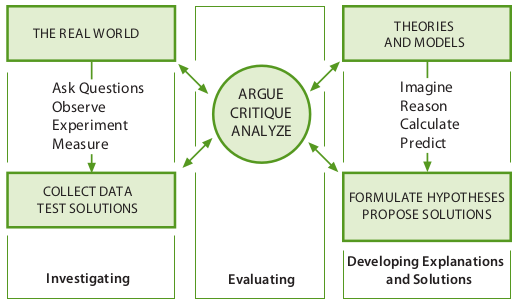
In 2012, systemic reform was again on the agenda: the Framework for K–12 Science Education was created by the National Research Council. In the first section A new conceptual framework, the views expressed on the three issues identified above are similar to those in the NSES:
…the framework is not intended to define course structure…[in]…technology, design, or… engineering… We simply maintain that some introduction to engineering practice, the application of science, and the interrelationship of science, engineering, and technology is integral to the learning of science for all students. …Engineering and technology are included as they relate to the applications of science, and in so doing they offer students a path to strengthen their understanding of the role of sciences. …throughout history, advances in scientific understanding often have been driven by engineers’ questions as they work to design new or improved machines or systems.
At this point, there is a clear view that a role of technology is to drive advances in science.
The third section, Dimension 1: Scientific and engineering practices (pp41-82), sets out competencies which students should have by grade 12, and outlines how they should progress towards these goals. In the introduction, a subsection on How Engineering and Science Differ gives an example of practical motives for scientific research: certain kinds of scientific research, such as that which led to Pasteur’s fundamental contributions to the germ theory of disease, were undertaken for practical purposes...
(p47). The distinction between science and engineering is described as:
the goal of science is to develop a set of coherent and mutually consistent theoretical descriptions of the world that can provide explanations over a wide range of phenomena, For engineering, however, success is measured by the extent to which a human need or want has been addressed.(p48)
The point is not made, however, that on this criterion Pasteur's work on fermentation and souring would not be a kind of scientific research
, but rather a kind of engineering. An afterword to the section, Reflecting on the practices (p78-9) takes a less positive view of technology, the only reference to it being:
Scientists use the resulting theories and the models that represent them to explain and predict causal relationships. When the theory is well tested, its predictions are reliable, permitting the application of science to technologies and a wide variety of policy decisions.
In this view, technology does not intervene in the production of knowledge, but just receives it in finished form from science. Perhaps there are differing and even contradictory views in play in the framework too.
The the basis for constructing standards from the framework is embodied in Dimension 3: Disciplinary Core Ideas, organized in sections 5 to 8: Physical, Life, and Earth and space sciences, and Engineering, technology, and applications of science. These sections include end points, which specify goals for student competencies in the range of grade bands. Whatever differing views are expressed in the introductory sections, the content of these grade band endpoints should represent the outcome, to be taken away and used in standards. Of particular, relevance is Section 8, containing ETS1: Engineering Design and ETS2: Links Among Engineering, Technology, Science, and Society.
The description of the ideas in ETS2 is quite specific on the role of technology as a driver for science, for example: Scientists and engineers often work together in teams, especially in new fields, such as nanotechnology or synthetic biology that blur the lines between science and engineering
, and In addition, engineers’ efforts to develop or improve technologies often raise new questions for scientists’ investigation
, and in the Grade Band Endpoints for grade 8: In order to design better technologies, new science may need to be explored (e.g., materials research prompted by desire for better batteries or solar cells, biological questions raised by medical problems).
It seems that in any standards based on the core ideas of the framework, this view should come across clearly.
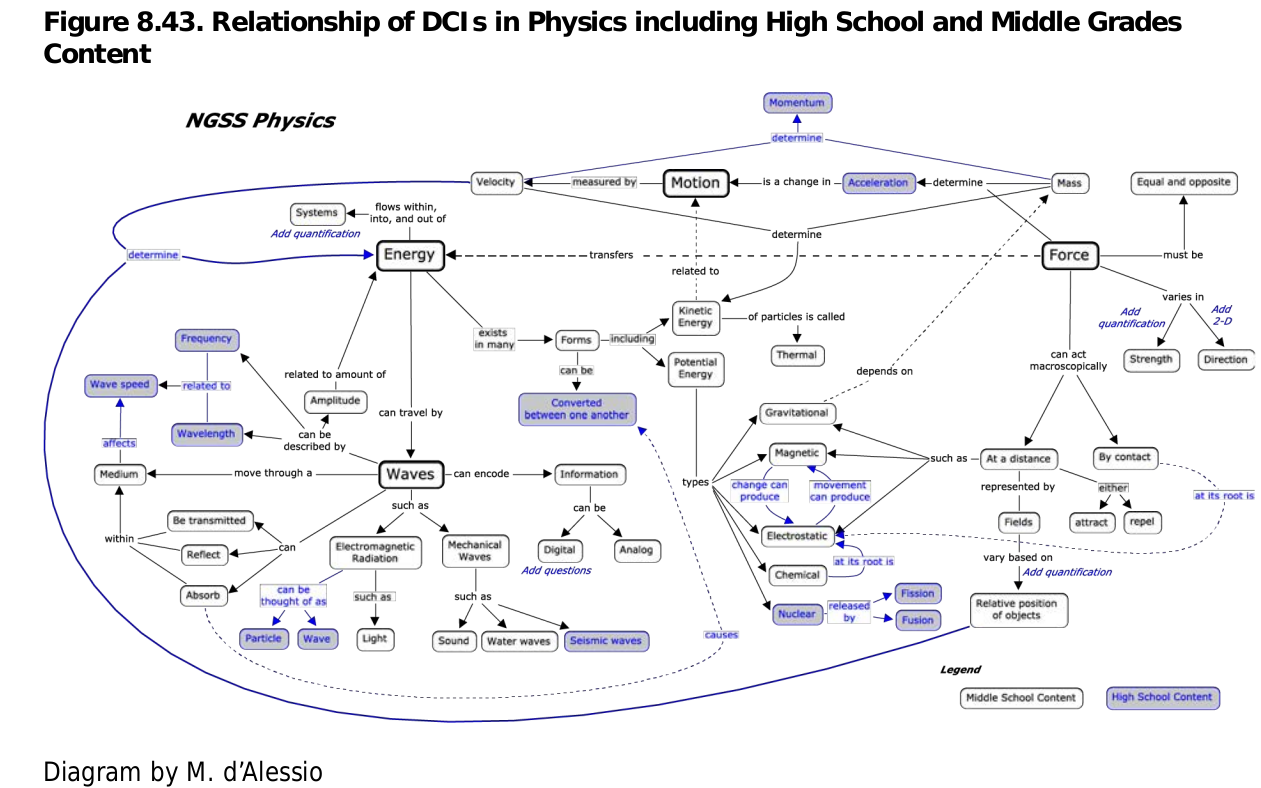
The framework is the basis for the Next Generation Science Standards (2015). In most states of the union the adoption of the NGSS marked the first time that engineering was made an explicit part of the science standards. In these states it also represented a pedagogical advance, for example in the California 2016 Science Framework, Ch 8 p1023: It is no longer sufficient for students to simply “know” facts about science, they need to be able to apply science and engineering practices...
.
In the NGSS the core ideas from ETS2 are presented in Appendix J. The examples it gives of the Interdependence of Science, Engineering, and Technology are: the development of telescope technology as advancing astronomical research; and the scientific discoveries of early explorers of electricity as enabling the development of power and communications by engineers. The early exploration of electricity could have been used to furnish examples of scientific research being driven by practical objectives (e.g. Priestly 1775, p102ff, 366-387), but this opportunity to link with a core idea in ETS2 was not taken.
The core ideas are developed into a Science, Technology, Society, and the Environment Connections Matrix in the appendix. The matrix contains seven connections statements: they refer to the use of engineering in scientific research and the value of science for developing technologies, but not to technology as a driver for science. This pattern is followed in the 23 student Performance Expectations which reference the statements.
Review
It seems unlikely that the reason why one of the core ideas from the K-12 framework has been left out of the NGSS of is lack of thoroughness: the NGSS have been reviewed and approved as conforming to the framework by the NRC. One possible reason is that the view of science as the origin of innovation has prevailed: several indications of that have been identified above, and several more are found on the Understanding Science site below.
Another factor that might contribute to this omission is that engineering is being used primarily as a vehicle for enhancing the teaching of core science. This means that technical problems are presented to demonstrate the application of particular core ideas. That will show only how technology is supposed to be a product of science. To demonstrate the converse, the student has to be allowed to approach a technical problem or opportunity in its own terms, and the science be left to fall where it will. Such an activity does not fit into the structure of the science standards, where design has been arranged around the core ideas of the science disciplines.
The creation and widespread adoption of the NGSS in the USA marks a step up in the presence of engineering design in standards in the great majority of states that have adopted it, and that means that more students are likely to engage with more technical issues in the classroom. Their new experiences may convince them that technology is a product of science, or it may do the reverse. The outcome depends on the understandings of the curriculum builders and teachers; the next section looks at one resource which might influence them.
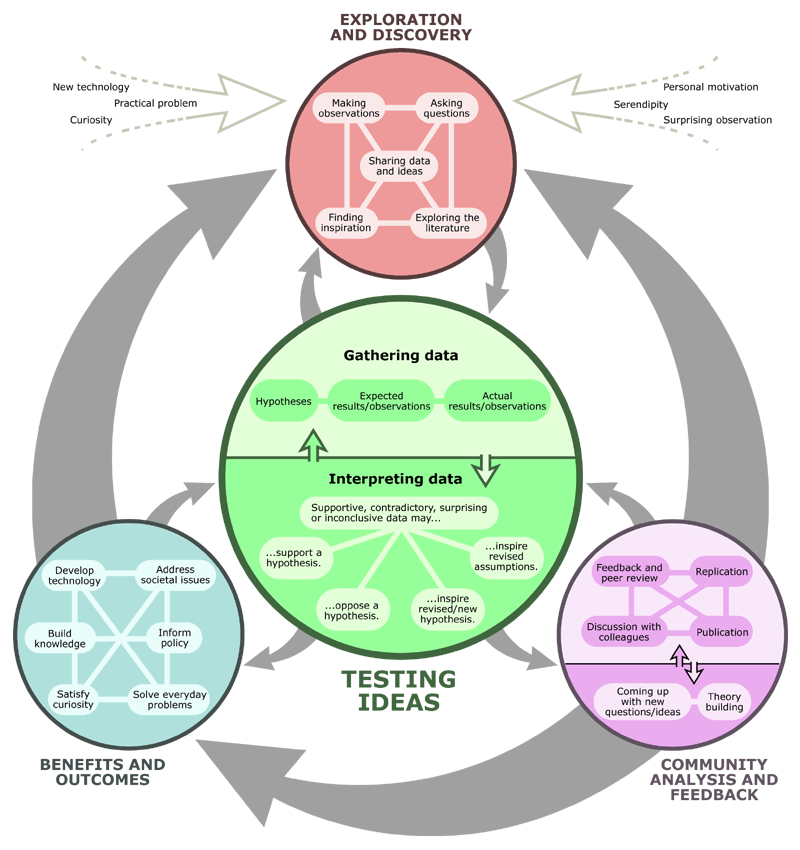
Understanding Science
The Understanding Science project based at the University of California at Berkeley has at its heart a re-engagement with science that begins with teacher preparation and ends with broader public understanding.
The careful and informative description of science on the web pages covers academic research, but not technical development. Teachers are recommended to use How science works: The flowchart to inform themselves and their students.
On The science checklist applied the question is posed: How is technology development similar to and different from science?
, and answered:
Science builds knowledge of how the natural world works, engineers use that knowledge to develop useful technologies, and these technologies may, in turn, provide key observations and tools that help scientists build even more knowledge of the natural world. Despite this close relationship, the two fields are distinct in that the main aim of engineering is applying scientific ideas in practical ways — not figuring out how the natural world works.
The nature of technology is explained as:
The notion of technology includes any sort of designed innovation. Whether a flu vaccine, the technique and tools to perform open heart surgery, or a new system of crop rotation, it's all technology. Even simple things that one might easily take for granted are, in fact, science-based technologies: the plastic that makes up a sandwich bag, the genetically-modified canola oil in which your fries were cooked, the ink in your ballpoint pen, a tablet of ibuprofen — it's all here because of science.
The question What has science done for you lately? is answered by saying that science was necessary for the development of electrical technology, early plastics, the Green Revolution and vaccination.
The problem here is that at least seven of these technologies were a product of practitioner experience and a development process targeted on a clear practical objective, and not a product of figuring out how the natural world works (for example ibuprofen). Technologies they have chosen to illustrate what science has done for you
were actually produced by technology development processes, as defined in their own technology checklist. Subsequently, once these technologies were established, some attracted interest from academic research, and were improved or promoted. Academic research may have contributed to the technologies' present form, but it is a misrepresentation to say that they are all here because of it.
The Understanding Science site is referenced in the science subject guides of the International Baccalaureate, which also include extensive descriptions of the nature of science, technology and design.
The International Baccalaureate®
Although the IB has a presence throughout the world, the majority of entrants for the diploma programme are from the Americas, mainly the USA. The works cited in the bibliography used to inform the programme's curriculum review are from the US and the UK, with one from Canada. The science subject guides for the programme include How science works: The flowchart. The programme is presented as offering a challenging academic curriculum that serves as outstanding preparation for university and higher education
. The curriculum may give an indication of the material that HE institutions in the US and UK value most highly.
The diploma programme Physics guide 2014 has sections on the nature of science and of physics, and the Design technology guide 2014 has sections on the nature of design and of design technology. These sections are carefully thought out, mutually consistent, and substantial: the section on the nature of science is seven times as long as the corresponding section from the Massachusetts 2006 framework. In the introductions to the guides, some of the commentary on technology is familiar:
Technology emerged before science, and materials were used to produce useful and decorative artefacts long before there was an understanding of why materials had different properties that could be used for different purposes. In the modern world the reverse is the case: an understanding of the underlying science is the basis for technological developments.… The application of scientific discovery to solve a problem enables designers to create new technologies. These new technologies in their turn drive developments in science…Scientists also have to be ready for unplanned, surprising, accidental discoveries. The history of science shows this is a very common occurrence.
Most of the curriculum topics in the physics guide include references to applications; these seem to be given to add interest and relevance, and not to be assessed in the examination papers. One option amounting to 10% of teaching hours has to be chosen from four, two of which are technical in nature. The Design technology curriculum has many references to innovation, none of which concern the application of scientific discovery or the creation of new technologies; instead, new technologies are flagged as a valuable source of innovation.
These science and technology curricula are arranged independently of each other, without being constrained by fixed links between them, or by adherence to the detail of the introductory material. Students have the option to choose how much science and/or technology they wish to take. Only a small minority take technology subjects, which is consistent with the admissions practices in US and UK universities.
Two of the extracts above highlight the importance of accidental discovery in modern science, and several describe how early technology has been transformed by the advent of scientific understanding. Taken together, these propositions are a conundrum: early technology was improved by experimental explorations, and accidental successes, when combined with a spirit prepared by experience, led to progress. So a process that has always been part of technology is being identified as a characteristic of science, and then science as the basis for technology. This circularity can be resolved by recognising that the experimental explorations characteristic of early technology remain an important part of modern technology, and science.
Science in the National Curriculum, England
The establishment in 1989 of the first National Curriculum for England, and its subsequent reforms, sustained a two centuries long tradition of reports advocating educational reforms that are not brought to fruition in subsequent legislation. In 1985 Science 5-16: A statement of policy, from the Department of Education and Science, recommended decisive changes to strengthen the relationship between science and technology:
Pupils should also use their science in technological activities which pose realistic problems to be solved and involve designing and making.…Teaching should also be closely related to everyday and industrial applications of science: science and technology are intimately linked, and understanding of scientific concepts can and should be greatly enhanced by the study of their technological applications…. …Links between teachers of science and CDT teachers are vital if a damaging and unnecessary division between science and technology is to be avoided. All science courses should have a technological content, and all technology courses should have a scientific content. … Hitherto problems tackled in science courses have rarely required pupils to use their scientific knowledge and skills in the design and development of a device or system capable of providing an answer to a particular need. Courses need to be developed which foster the essential scientific content, skills and processes while at the same time providing opportunities for related technological work.
These recommendations amount to a major reform of how science and technology are presented in schools, with major resource implications.
Science in the National Curriculum 1989
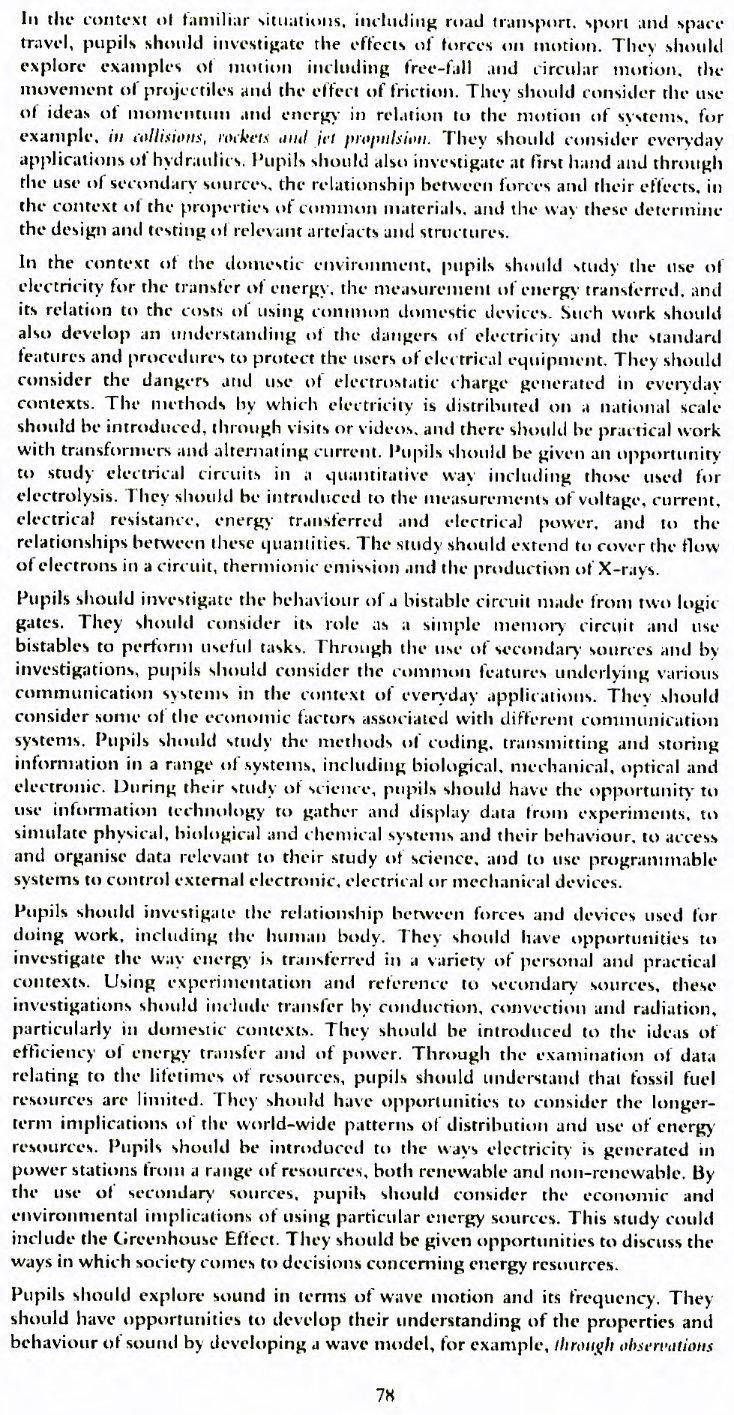
The Programmes of Study set out in the 1989 Science in the National Curriculum are, in parts, in line with the above policy statement: they specify detailed learning activities which relate science to everyday technical practice. The National Curriculum also specified Design and Technology as a foundation subject, and asked for it to demonstrate links to the sciences. Problems with implementing the curriculum as a whole led to revisions which simplified it in 1991Department of Education and Science and the Welsh Office (1991) SCIENCE for ages 5 to 16(1991),. London: HMSO (web), then to a major review in 1994 intended to slim the curriculum down to a manageable size. In the 1995 Science in the National Curriculum the previous Programmes of Study were removed, and replaced with itemised lists of topics to be covered.
The continued presence of technical practice in the revised curriculum is evident in many topics in the lists. The lists are separated into disciplines of life sciences, chemistry and physics. In KS4 (the two final years of study), in life sciences the count of items related to technical practice was 28 out of a total of 48 items, in chemistry it was 25/62 and in physics 19/67. Subsequent revisions to the science curriculum have retained the same format, so the changes to the presence of technology can be tracked by how these counts vary.
In 2002 a review commissioned by the UK Government, SET for success: The supply of people with science, technology, engineering and mathematics skills (pdf), reported that:
There have been many studies in recent years of the science curriculum and its role in enthusing pupils to study science at higher levels. These studies have drawn on the views of pupils, parents, teachers and others with an interest in this area. Their conclusions, which were matched by concerns expressed in the Review’s consultation, were that:
- pupils are sometimes ‘turned off’ science by what they see as excessive repetition and too much emphasis on the volume of scientific knowledge required at the expense of discussion of potentially more enjoyable and contemporary elements of science;
- too many pupils view the curriculum, particularly those areas related to for physics and chemistry, as lacking relevance to everyday life and to topical science stories appearing in the media, and that this lack of relevance was seen as a particular issue for girls;
- the emphasis on knowledge and lack of relevance makes it hard for pupils to make a link between what they learn and potential careers;
- the curriculum is overcrowded and assessment is based too much on memorisation and recall, which is unrepresentative of how science is used later in life;
- there are insufficient links made between issues covered in science and those covered in mathematics, ICT and D&T (in particular), which makes it more difficult for the pupil to see the close connections between these subjects, both in terms of further study and future careers.
The subsequent revision of the curriculum in 2004 made only a gesture in the direction of the problems reported in SET for success, by rearranging the presentation of the programmes of study. Three topics concerning the Applications and Implications of Science were placed under the heading How science works, and four that concerned uses of science were placed under the heading Breadth of study.
In November 2010 a UK government white paper The Importance of Teaching announced that the debate on educational standards was a side issue, because
...what really matters is how we’re doing compared with our international competitors. …The truth is, at the moment we are standing still while others race past. In the most recent OECD PISA survey in 2006 we fell from 4th in the world in the 2000 survey to 14th in science,...
Actually the truth is that in 2000 the UK was 5th in science, and in 2006 five of the countries placed higher than the UK were not in the 2000 survey, so between those surveys the UK was overtaken by four countries, not ten. Among other complex ongoing reforms to public examinations, school organisation, testing and accountability systems, intended to reverse the perceived falling off, the government undertook to review and reform the whole English National Curriculum, for implementation in September 2013.
The National Curriculum review Standard Note SN 06798 (2014 pdf) describes how the review proceeded, saying
many commentators have raised concerns about both the review process, and its outcomes. They have queried the level of involvement of specialists in determining the subject content, the degree of prescription in terms of what should be taught, and to what extent the new curriculum is likely to meet the Government’s stated aims.
The customary procedure of commissioning expert advice and not following it, carrying out consultations and not responding to feedback, then finally implementing changes based on preconceived ideas, was followed at breakneck speed. In October 2011 two of the four expert panel members gave notice of resignation because
we are concerned with the directions which the Department now appears to be taking. Some of these directions fly in the face of evidence from the UK and internationally and, in our judgement, cannot be justified educationally.
The minister persuaded them back onto the panel, with the assurance that their work would not be presented as an endorsement of the eventual content of the curriculum. A consultation on the programmes of study in the spring of 2013, generated a very large number of responses. A coalition of bodies involved in science teaching and research, SCORE, was particularly concerned
that the focus on increasing rigour primarily through the addition of content has led to a curriculum that will not achieve these [stated] aims. … that students will be given an inauthentic experience of [the sciences] as being collections of unconnected facts … that the content of the science curriculum [be] structured with proper consideration being given to areas of overlapping content… (pdf).
In 2012 the report commissioned by the Department for Education, What can we learn from the English, mathematics and science curricula of high-performing jurisdictions? (pdf), reported that all four of the overseas comparator jurisdictions for the science curriculum place great emphasis on technology
which is not particularly emphasised in England
. The curriculum finally published in Science programmes of study: key stage 4 (2014 pdf) shows changes from the 1995 curriculum that go against the feedback from consultation, and the international comparisons. The counts of items in the 2014 programmes of study relating to technical practice are 26/45 in Biology, 10/37 in Chemistry and 5/41 in Physics. Whilst the connections to practice remain strong in Biology, those in Chemistry and Physics have been drastically reduced in the reform.
Unlike Science in the National Curriculum in 1995, the 2020 National Curriculum for science includes introductory material on the relationship of science and technology:
A high-quality science education provides the foundations for understanding the world through the specific disciplines of biology, chemistry and physics. Science has changed our lives and is vital to the world’s future prosperity, and all pupils should be taught essential aspects of the knowledge, methods, processes and uses of science. Through building up a body of key foundational knowledge and concepts, pupils should be encouraged to recognise the power of rational explanation and develop a sense of excitement and curiosity about natural phenomena. ...students should be taught so that they develop understanding and first-hand experience of... explaining everyday and technological applications of science. … Physics is the science of the fundamental concepts ... which are inter-linked to form unified models... From such models, a wide range of ideas, from the broadest issue of the development of the universe over time to the numerous and detailed ways in which new technologies may be invented, have emerged.
Science is portrayed as an independent body of knowledge, which feeds into technology and enables its advance.
A compatible view of the relationship between science and technology is evident in the curriculum for Design and Technology, which is defined in the GCSE subject content option for key stage 4, and in the National Curriculum for earlier stages. The GCSE specifications should also provide opportunities for students to apply knowledge from other disciplines, including mathematics, science, art and design, computing and the humanities
. This general requirement is made more specific: the content must require students to demonstrate the mathematical and scientific knowledge, understanding and skills set out in appendix 1.
This should provide some concrete examples of how science feeds knowledge into technology, but the nine Scientific knowledge and skills requirements listed are not foundational scientific concepts, they are rather technical topics, and the science curriculum actually treats only six of them. The D&T curriculum generally treats these topics more extensively, with some overlap with their treatment in the science curriculum. The knowledge and skills that have been attributed to science are technical in origin, and are more appropriate to illustrate how science applies knowledge from technology than the reverse. Mathematical knowledge is required for D&T, as it is for sciences: in the D&T GCSE question papers there is a requirement for geometry and statistics in particular.
Review
The evidence from the curriculum development processes in England and the USA indicates a debate in which the predominant view is challenged, but prevails. The view is that the curriculum should be based on core science ideas, which provide the basis for the learner to live or work with technology, just as they provide the basis for technical innovations. A science curriculum based on this view is indigestible and unpopular, so there has been pressure for change. In the USA material is being developed to introduce design exercises into science classes, to engage students and to demonstrate the use of core ideas. These will be spread across the curriculum, giving no focus for technical activities. The evidence that technology is a driver for scientific research was not adopted as part of published standards, apparently due to a lack of awareness of its significance. In England the early development of a national curriculum for science included a substantial amount of technical content, but later revisions have reduced this. Technical content is almost absent from A-levels (pdf), the gateway examinations for university admission. This is apparently due to a conviction that since there is a correlation between high achievement and aptitude for core science, an increase in core science content will result in higher achievement all round.
The standards and curricula examined above illustrate how technology may be fitted into a science standard, or sit alongside science as an alternative. The former ensures that all students encounter technology, but only as secondary to core science. The latter allows a free exposition of technology, but in practice reaches only a minority of students in general education.
The curriculum development process has evoked differing views. An even wider range of views, and many proposals and projects for reform, have arisen from practice and research in education. A number of these are discussed in the next section.
From practitioners and reformers
The way in which differing views of the relationships between science and technology are expressed in the curriculum has been expounded by Paul GardnerPaul Gardner, Representations of the Relationship between Science and Technology in the Curriculum, Studies in Science Education (1994), 24:1, 1-28 doi . He identifies four views:- (i) science precedes technology... often called the technology as applied science (TAS) view, is widely held and influential. (ii) science and technology are independent, with differing goals, methods and outcomes... (iii) technology precedes science; ...experience with tools, instruments and other artefacts is necessary for conceptual development. (iv) technology and science engage in two-way interaction. He looks at how these views have been expressed in the curriculum: for the first, dominant, view he finds six ways that the associated curricula are limited or misleading; the third view is rarely expressed, but without it the curriculum is inflexible and historically misleading. Gardner's analysis has been influential in a local reform: a unified science and technology curriculum for ages 9-14 was created in Israel after 1994 (BarakMoshe Barak, Eli Raz, Hot-Air Balloons: Project-Centered Study as a Bridge between Science and Technology, Education Science Education 84: 27-42, 2000).
David LaytonDavid Layton, Technology's challenge to science
education: cathedral, quarry or company store? Open
University Press, 1993(1993) shows how technology forms a body of knowledge independent from, but related to, science. He explores the implications of this for routes to learning, and highlights the magnitude of the resources required to make the changes happen. The same author describes the differing and conflicting interests at play in the introduction of the Design and Technology curriculum in England (LaytonDavid Layton, Constructing and Reconstructing School
Technology in England and Wales, International Journal
of Technology and Design Education 5:89-118, 1995(1995)). He points out the failure to provide for the resources needed: …the presumptions seem to be that the science of science lessons is ready made for use in D&T tasks, and that technology teachers will embrace this resource. Both are questionable
.
In a report produced in 2000 for the UK Engineering Council and Engineering Employers’ Federation, David Barlex recommends coordination and collaboration between science and technology teaching, but not integration of the two. One reason for this is the concern that the distinctive nature of technology would not be retained if it were merged into a single course. The rationale for separation has been further developed by P John WilliamsWilliams, P. J.. Processes of science and technology: A rationale for cooperation or separation. In Paper presented at the PATT 12 conference: Technology education in the curriculum: Relationships with other subjects, Columbus, OH (2002). pdf, who concludes that
Generally they are so different in so many ways that the processes themselves are dissimilar. If however the processes are broken down into more specific skills, then there seems to be a number of parallels at this level. The advantage in the recognition of these parallels is that students may get practice in doing similar things in different contexts
The Nuffield Foundation has been a source for local reforms, and a contributor to systemic reforms, in education in the UK since 1962, particularly in science. The main finding from the Beyond 2000: Science education for the future project was Our view is that the form of science education we currently offer to young people is outmoded, and fundamentally is still a preparatory education for our future scientists.
They also emphasise the value of learning, and learning by, scientific inquiry. One of their ten recommendations is Work should be undertaken to explore how aspects of technology and the applications of science currently omitted could be incorporated within a science curriculum designed to enhance ‘scientific literacy’.
Sandra Duggan & Richard GottSandra Duggan & Richard Gott, What sort of science education do we really need?, International Journal of Science Education, 24:7, 661-679, (2002) DOI cast doubt on whether the science education we currently offer is actually suitable as a preparatory education for our future scientists: they report that for practising scientists knowledge of procedures was more significant than knowledge of principles. They also find that for science in everyday life, the principles could be acquired as needed for the case in hand.
The STEM initiatives, designed to increase student enrollments in science, technology, engineering and maths, have not all had the same focus. Liu et alXiufeng Liu , Ling L. Liang & Enshan Liu, Science Education Research in China: Challenges and Promises, International Journal of Science Education, 34:13, pp1961-1970, (2012) DOI report that in China, changes have been made to connect the science content with technology that students encounter in their daily lives and to overcome the excessive respect for fundamentals and increase challenge and creativity by students. In The age of STEM : educational policy and practice across the world in science, technology, engineering and mathematics, Yuan GaoThe age of STEM : educational policy and practice across the world in science, technology, engineering and mathematics, edited by Brigid Freeman, Simon Marginson and Russell Tytler, Routledge 2015, p71. reports reforms in Taiwan to increase autonomy for teachers, to switch to teacher assessment and towards assessing inference instead of memory in science courses. In both places the need for extra training and resources for teachers has been highlighted. In the US, UK, Japan and NZThe age of STEM, p83-210, however, the STEM initiatives have focused on funding and communication rather than curriculum change. Ian DobsonThe age of STEM, p235 reports that in Finland, there is no lack of participation in STEM subjects: there they have separate but equal three-year vocational and general education streams post 16, both qualifying for admission to degree level courses, and teachers are autonomous and highly respected. The Finnish vocational institutes also retained their technical nature when they were upgraded in 1993 to deliver degree level teaching, in contrast to the polytechnics in the UK which were merged into the university system in the same period.
Recent research indicates that in the UK any deficit in STEM skills will not be made up by boosting graduate numbers: Emma Smith and Patrick White report in 2018 that
There is no evidence of a shortage of STEM graduates per se. Only a minority of STEM graduates ever work in HS [highly skilled] STEM occupations, and an even smaller proportion are employed in key ‘shortage’ areas. …Most highly skilled STEM workers are non-graduates. Any increase over time in the proportion of STEM workers with degrees appears to only reflect the historical increase in participation in higher education. Focusing too much attention on graduates ignores the source of the majority of the STEM workforce.
This is not just a recent issue: in 1943 the UK government white paper Educational Reconstruction found that
too many of the nation's abler children are attracted into a type of education which prepares primarily for the University and for the administrative and clerical professions; too few find their way into schools from which the design and craftsmanship sides of industry are recruited. If education is to serve the interests both of the child and of the nation, some means must be found of correcting this bias and of directing ability into the field where it will find its best realisation.
A shift of focus away from overarching concepts and core ideas, and towards procedures and practice is also apparent in some new ideas about science teaching in universities: The Chemistry XXI projectVicente Talanquer and John Pollard, Let’s teach how we think instead of what we know, Chem. Educ. Res. Pract., 2010, 11, 74–83 was developed under the premise that it would be beneficial to shift the focus of the first-year chemistry curriculum from acquiring core chemical knowledge, to mastering core ‘chemical ways of thinking’: …our intent is to focus the attention on the domain-specific chemistry-based ways of thinking that have proven to be so powerful and successful in analyzing, modeling, and transforming our surrounding world
. Yanlan Wan and Hualin BiYanlan Wan and Hualin Bi, Representation and Analysis of Chemistry Core Ideas in Science Education Standards between China and the United States, J. Chem. Educ. 2016, 93, 70−78 made a critical comparison of chemistry core ideas in the Chinese Chemistry Curriculum Standards (CCCS) and the U.S. Next Generation Science Standards (NGSS). They found that the CCCS chemistry core ideas include theoretical concepts, element and compound concepts, and chemical terminology and calculation concepts, while the NGSS mainly includes theoretical concepts. Tiffany-Rose Sikorski and David HammerTiffany-Rose Sikorski and David Hammer, Looking for coherence in science curriculum, Science Education. 2017;101:929–943 studied examples of prominent curriculum projects over the past decade, and found that premeditated coherence, the kind of coherence that is planned and designed for students, may inhibit students’ learning to seek coherence for themselves. They proposed an approach to curriculum and assessment that enables students to seek coherence for themselves.
Review
Technical activities and science are so mutually reinforcing and interconnected that it begs the question of why they are not learned together. One answer lies in the quantity of work needed to develop the resources to bring them together, another in the predominant view of their relationship to each other. This view allows only a subsidiary role for technology in any partnership with science education. A science education based on this view is unattractive and inappropriate for non specialists, and for the great majority of those who become practitioners. It may suite the few who enter academic research.
Review
The segregation of science and technology practised in England and the USA is accompanied by a vision of sciences as autonomous academic disciplines, constructed from knowledge discovered by academic research, and of technical advances being based on these discoveries. Within this vision the curriculum is organised around a system of core disciplinary ideas. There is a practical problem with this approach: the curriculum is designed for the minority of pupils who go on to specialise in sciences in higher education, and it discourages other pupils' interest in science and technology. In England, about one third of A levels are taken in science and technology subjects, whereas in France slightly more than half take these routes in the baccalauréat. The attempts to tackle this problem whilst maintaining the fixed vision produce no easy solution. The glimpses of technology obtained by design exercises constrained to illustrate predetermined concepts, or technical topics portrayed as applications of science, are scattered and misleading.
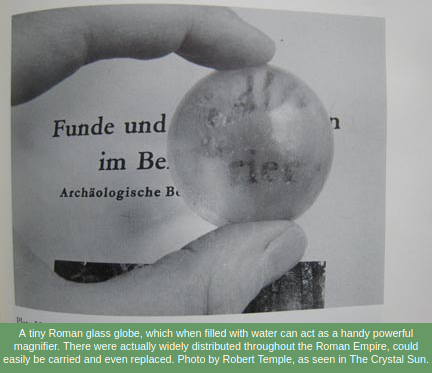
There is no pedagogical problem with presenting the issues and problems of technical developments first, and then leading on to the understandings required to tackle them. This approach is popular with teachers (Bell & DonnellyJacqueline Bell & James Donnelly (2009) Applied Science in the English school curriculum: the meaning and significance of ‘vocationalization’, Journal of Curriculum Studies, 41:1, 25-47, DOI ) and is analogous to the recommendation for science teaching (Using Phenomena in NGSS) that phenomena are presented first, and explanations afterwards. It is also consistent with the historical development of the subject, where developments take place in advance of understanding.
In the curricula where science and technology are segregated, several sources refer to past technical advances to illustrate how technology depends on academic research in science. These illustrations are not supported by reference to the historical record. They seem to be constructed on the basis of the belief that any innovative technical activity is science, even if the activity does not fit the constructor's description of what science is. They conform to a vision of how curiosity about nature leads to fundamental knowledge which is the enabler of change in technology, a view taken in 1945 , but generally rejected by 1972.
Given the advantages of a balanced approach to science and technology, and the viability of such an approach demonstrated elsewhere, the question arises as to why some nations do not adopt it. The differences between the four nations' educational approaches to science and technology can be compared with the differences between their histories. In France the state was involved in technical education by the the 18th century, whereas the early English experience was of little state involvement until the late 19th century, then continuing debate and policy shifts ever since (GreenAndy Green, Technical education and state formation in nineteenth-century England and France, History of Education, 1995 , VOL.24 , NO.2 , 123 – 139. ). In Scotland involvement goes back to the late 18th century. In the USA the key intervention was in 1862, with attitudes changing according to economic and political developments since then (GraysonL. P. Grayson, A Brief History of Engineering Education in the United States, IEEE Transactions on Aerospace and Electronic Systems, vol. AES-16, no. 3, pp. 373-392, May 1980, doi: 10.1109/TAES.1980.308907. ).
At the top of this page, it was suggested that histories of early steam power might be biased by their writers’ education. The evidence above shows that education in England and the USA expresses two views which combine to mislead its students. The lack of technology in general education is combined with the teaching that technology can be understood as derived from science. This means that the educated historian feels equipped to analyse early technical developments thanks to their science education, whilst being unable to carry out a technical analysis, and even being unaware of the nature of technical issues.
Conclusions
are drawn together on the Introduction and conclusion page.
References
- ^ Jacqueline Bell & James Donnelly (2009) Applied Science in the English school curriculum: the meaning and significance of ‘vocationalization’, Journal of Curriculum Studies, 41:1, 25-47, DOI
- ^ Andy Green, Technical education and state formation in nineteenth-century England and France, History of Education, 1995 , VOL.24 , NO.2 , 123 – 139.
- ^ L. P. Grayson, A Brief History of Engineering Education in the United States, IEEE Transactions on Aerospace and Electronic Systems, vol. AES-16, no. 3, pp. 373-392, May 1980, doi: 10.1109/TAES.1980.308907.
- ^ Department of Education and Science and the Welsh Office (1991) SCIENCE for ages 5 to 16(1991),. London: HMSO (web)
- ^ Robert Donmoyer, The Rhetoric and Reality of Systemic Reform: A Critique of the Proposed National Science Education Standards, Theory Into Practice , Winter, 1995, Vol. 34, No. 1, Reforming Science Education (Winter, 1995), pp. 30-34
- ^ Paul Gardner, Representations of the Relationship between Science and Technology in the Curriculum, Studies in Science Education (1994), 24:1, 1-28 doi
- ^ David Layton, Constructing and Reconstructing School Technology in England and Wales, International Journal of Technology and Design Education 5:89-118, 1995
- ^ David Layton, Technology's challenge to science education: cathedral, quarry or company store? Open University Press, 1993
- ^ Moshe Barak, Eli Raz, Hot-Air Balloons: Project-Centered Study as a Bridge between Science and Technology, Education Science Education 84: 27-42, 2000
- ^ Williams, P. J.. Processes of science and technology: A rationale for cooperation or separation. In Paper presented at the PATT 12 conference: Technology education in the curriculum: Relationships with other subjects, Columbus, OH (2002). pdf
- ^ Sandra Duggan & Richard Gott, What sort of science education do we really need?, International Journal of Science Education, 24:7, 661-679, (2002) DOI
- ^ Xiufeng Liu , Ling L. Liang & Enshan Liu, Science Education Research in China: Challenges and Promises, International Journal of Science Education, 34:13, pp1961-1970, (2012) DOI
- ^ The age of STEM : educational policy and practice across the world in science, technology, engineering and mathematics, edited by Brigid Freeman, Simon Marginson and Russell Tytler, Routledge 2015, p71.
- ^ The age of STEM, p83-210
- ^ The age of STEM, p235
- ^ Vicente Talanquer and John Pollard, Let’s teach how we think instead of what we know, Chem. Educ. Res. Pract., 2010, 11, 74–83
- ^ Yanlan Wan and Hualin Bi, Representation and Analysis of Chemistry Core Ideas in Science Education Standards between China and the United States, J. Chem. Educ. 2016, 93, 70−78
- ^ Tiffany-Rose Sikorski and David Hammer, Looking for coherence in science curriculum, Science Education. 2017;101:929–943
